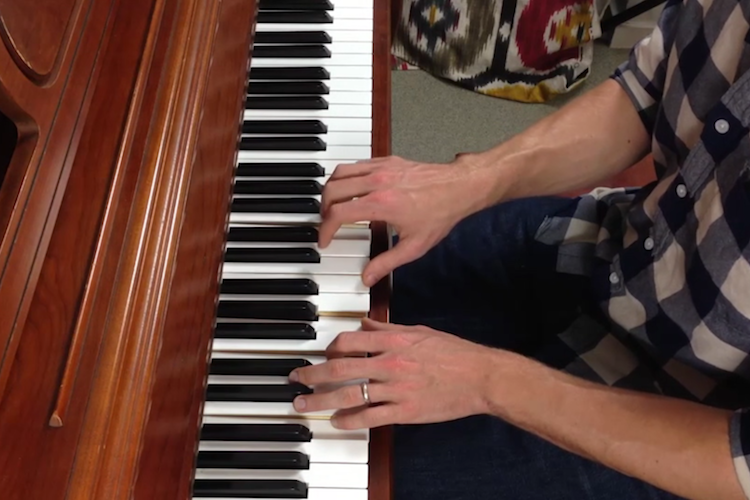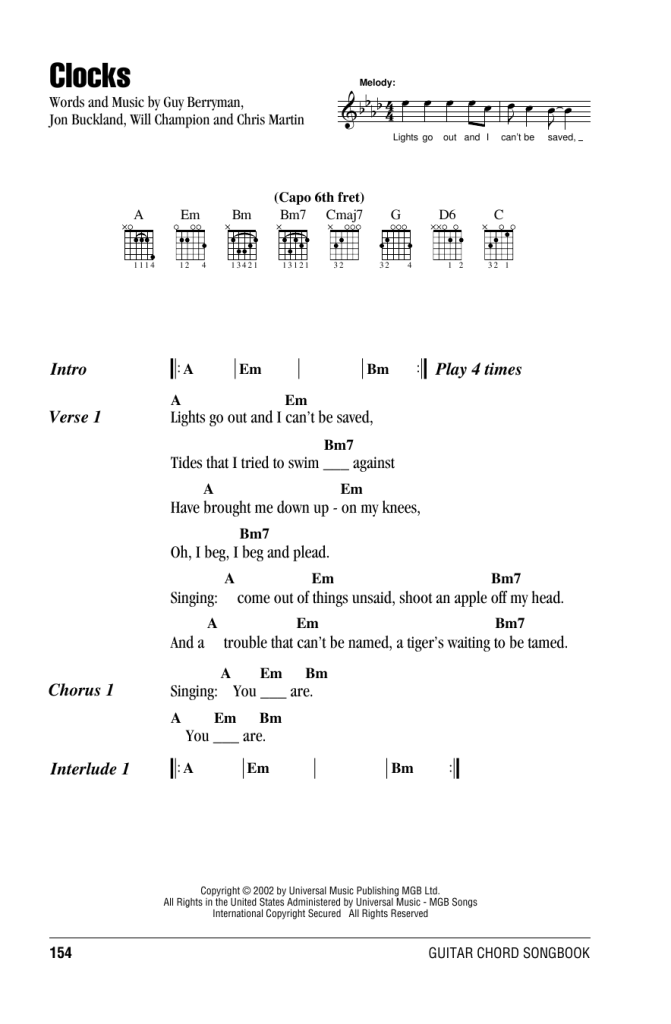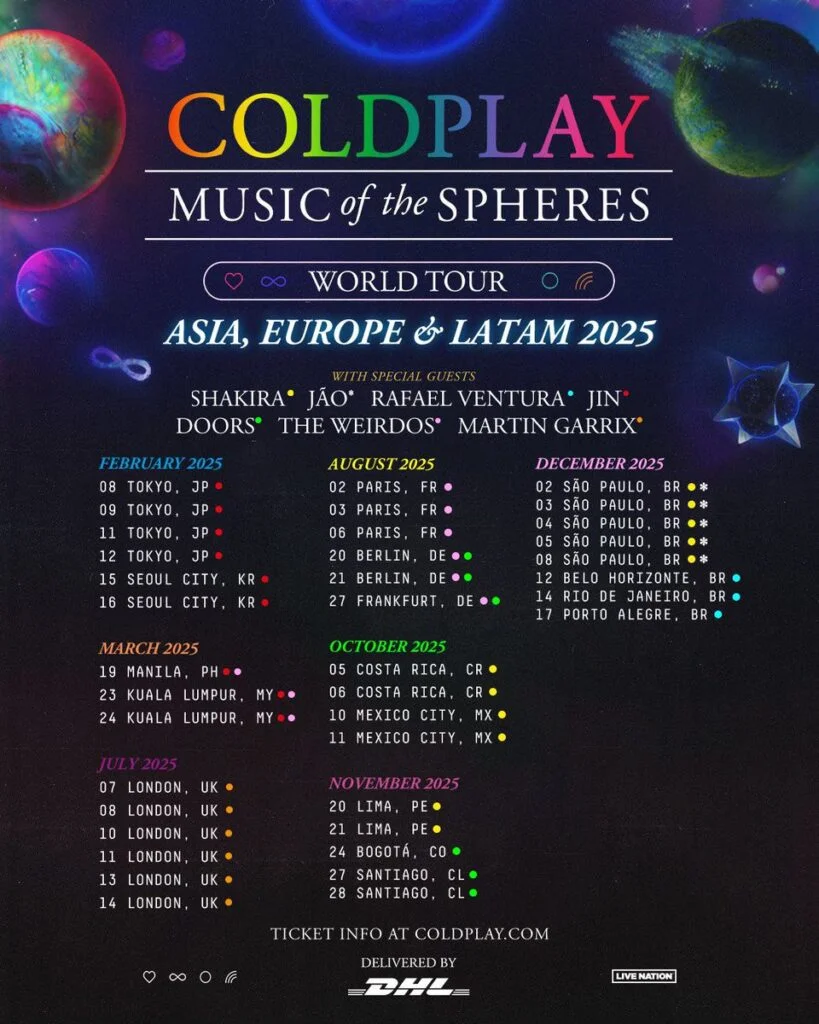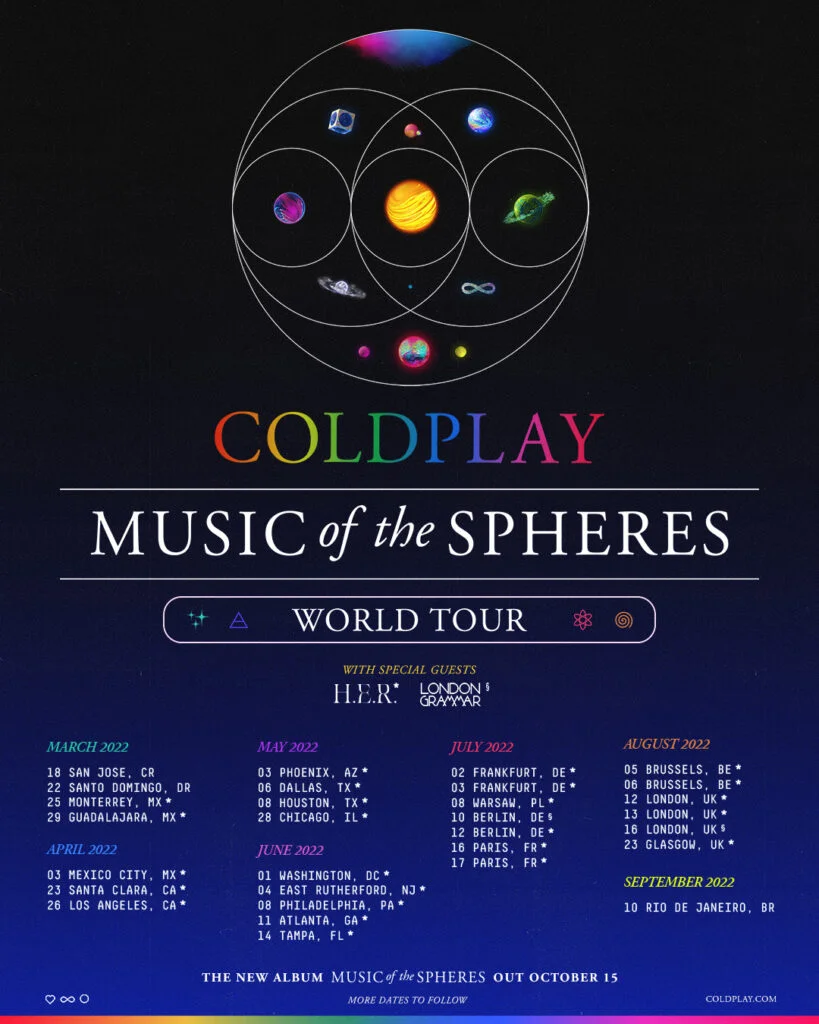Are you a fan of Coldplay’s iconic song “Clocks” and dream of playing it on your guitar? Delving into the captivating chords of this timeless hit can be a rewarding journey for any musician. Understanding the intricate chord progressions that underpin this track is essential to genuinely capturing its essence.
In this blog, we will explore mastering the chords for Coldplay’s “Clocks.” From deciphering the signature piano riff to unravelling the harmonious blend of chords, we will provide you with the tools and insight needed to bring this classic track to life on your guitar.
Join us as we unlock the melody of “Clocks” and explore the magical world of Coldplay’s music through its enchanting chords.

Introduction: Exploring the Iconic Song ‘Clocks’ by Coldplay
“Clocks” by Coldplay is undoubtedly one of the most iconic songs of the modern era. It is known for its mesmerizing piano melody and poignant lyrics. Released in 2002, this timeless track resonates with listeners worldwide, making it popular for music enthusiasts and aspiring musicians. This section will delve into the chords and musical intricacies that make “Clocks” a standout piece in Coldplay’s discography.
The Musical Legacy of “Clocks”
One of the defining features of “Clocks” is its distinctive chord progression, which instantly captivates listeners from the opening notes. The song’s recurring piano riff, played by the talented Chris Martin, sets the tone for the entire composition.
Mastering the Chords for “Clocks”
Mastering the chords is essential to playing “Clocks” on the piano or guitar. The song primarily revolves around the chords of C major, D major, and F major, creating a harmonious blend of melancholy and optimism.
Whether you are a beginner or an experienced musician, learning these chords and their transitions can unlock the magic of “Clocks” and allow you to recreate its vibrant energy in your rendition.
Connecting Through Music
Music uniquely transcends barriers and evokes emotions that words alone may struggle to express. Through the universal language of “Clocks,” Coldplay has connected with millions of fans worldwide, leaving a lasting impact on the music industry.
- Discover the emotional depth of the song through its evocative lyrics
- Explore the chords and melodies that define the signature sound of “Clocks.”
- Experience the magic of Coldplay’s musical legacy through this timeless classic.

Understanding Chords: A Fundamental Element of Music Theory
A chord is a set of three or more notes played together to create harmony in music. Understanding chords is essential for any musician, whether you are a beginner or an experienced player. In the song ‘Clocks’ by Coldplay, mastering the chords is crucial to capturing the essence of the melody.
The Basics of Chords
Chords are built on scales, a series of notes arranged in a specific order. The most common chords are major and minor, evoking different musical emotions. In ‘Clocks’ by Coldplay, the chords used create a sense of melancholy and nostalgia.
Chords for ‘Clocks’ by Coldplay
To play ‘Clocks’ by Coldplay, you must familiarize yourself with the chords E♭ major, B♭ major, F minor, and C minor. These chords form the song’s backbone and give it its distinctive sound.
Pro Tip: Practice transitioning between these chords smoothly to enhance your performance of ‘Clocks’.
Mastering Chords Technique
To master chords for ‘Clocks’ by Coldplay, practice each chord individually until you can play them effortlessly. Utilize chord charts and tutorials for guidance. Remember, practice makes perfect!
- Start slow and gradually increase your speed.
- Focus on proper hand positioning for each chord.
- Use a metronome to improve your timing.
Deconstructing the Chords in ‘Clocks’ for Analysis
When it comes to understanding the chords in Coldplay’s iconic song “Clocks,” it’s essential to dive deep into the musical structure that underpins this timeless hit. Let’s break down the chords used in this song to unravel the magic behind its melody and harmony.
The Chord Progression
The chord progression in “Clocks” revolves around a mesmerizing pattern of chords that create the song’s distinctive sound. The primary chords used in this song include Am7, Em7, Dm7, and G7. These chords blend to form a captivating harmonic backdrop for the soaring vocals.
Analyzing the Chords
Each chord in “Clocks” plays a crucial role in shaping the overall mood and feel of the song. The Em7 chord, for example, adds a sense of melancholy and introspection, while the Dm7 chord brings a touch of drama and tension to the composition.
Furthermore, the G7 chord introduces a moment of resolution and brightness, contrasting the more sombre tones of the other chords. This careful balance between light and shadow makes the chord progression in “Clocks” so compelling.
View this post on Instagram
Mastering the Rhythm: Syncopation and Time Signatures in the Song
Understanding the rhythm, syncopation, and time signatures is crucial when mastering the chords for Coldplay’s “Clocks.” Syncopation involves emphasizing off-beat rhythms, creating a unique feel to the song. In “Clocks,” the syncopated piano riff drives the melody forward, contributing to its distinctive sound.
The Importance of Syncopation
Syncopation adds complexity and depth to the music, making it more engaging for listeners. The syncopated rhythm in “Clocks” keeps the song moving dynamically, drawing the audience in with its unexpected accents and patterns.
Understanding how to play the syncopated sections correctly is essential to capturing the song’s essence and conveying its energy effectively.
Decoding Time Signatures
The time signature of a song dictates its rhythmic structure and how the beats are organized. In “Clocks,” the song is in 4/4 time, meaning there are four beats per measure, with each beat receiving a quarter note.
Mastering the time signature ensures you stay in rhythm throughout the song, allowing you to play confidently and accurately.
Tips for Playing the Chords: Techniques and Practice Strategies
Mastering Coldplay’s chords for ‘Clocks’ requires dedication and proper technique. Here are some tips to help you perfect your chord playing:
1. Finger Placement
Ensure your fingers are placed correctly on the guitar fretboard or piano keys to produce clear and crisp sounds. Practice transitioning between chords smoothly.
2. Practice Regularly
Consistent practice is critical to improving your chord-playing skills. Set aside dedicated time each day to practice Coldplay’s chords for ‘Clocks’.
3. Use a Metronome
Stay in rhythm by practising with a metronome. This will help you sense timing and improve your chord changes.
Exploring Variations: Creative Ways to Interpret the Chords
Mastering the chords for “Clocks” by Coldplay opens up a world of musical possibilities. To truly unlock the melody, exploring variations and finding creative ways to interpret the chords is essential. By infusing your unique style into the arrangement, you can breathe new life into this iconic song.
Experiment with Different Voicings
One way to add a fresh perspective to the chords is to experiment with different voicings. Try variations in the inversion of the chords to create a more dynamic sound. This can help craft a unique interpretation of the song while staying true to its essence.
For example, you could try playing the chords in higher octaves or using open chords to bring out a brighter, more resonant tone. These subtle changes can significantly impact the overall feel of the music.
Explore Rhythmic Patterns
Another way to get creative with the chords is by exploring rhythmic patterns. Experiment with different strumming or picking techniques to add texture and depth to the arrangement. These variations can help in enhancing the emotional impact of the song.
Consider incorporating syncopation or arpeggios into your playing to create a rhythmic pulse that complements the melody. You can craft a unique version of “Clocks” that showcases your musical prowess by playing around with tempo and rhythm.
Unlocking the Emotional Depth: How Chords Enhance the Song’s Message
When mastering the chords for “Clocks” by Coldplay, understanding how chords can enhance a song’s emotional depth is critical. Chords form a piece’s harmonic structure, setting the composition’s mood and tone. In the case of “Clocks,” the blend of piano chords creates a sense of urgency and introspection, amplifying the song’s message.
The Power of Minor Chords
In “Clocks,” the strategic use of minor chords adds a touch of melancholy and contemplation to the music. The transition between minor and major chords gives the song its emotional depth, creating a juxtaposition of feelings that resonates with the listeners.
Harmonic Progressions and Emotional Impact
The harmonic progressions in “Clocks” are pivotal in conveying the song’s message. The music evokes a sense of journey and resolution by moving through different chord sequences. The layering of chords builds tension and release, heightening the song’s emotional impact.
View this post on Instagram
References and Resources for Further Learning
If you want to delve deeper into mastering the chords for “Clocks” by Coldplay, here are some valuable resources you can explore:
1. Online Tutorials and Courses
Check out online platforms such as Udemy or Coursera for comprehensive guitar lessons on playing chords for “Clocks”.
You can also find helpful video tutorials on YouTube by renowned guitarists demonstrating the chord progressions for this iconic Coldplay track.
2. Guitar Tab Websites
Explore popular guitar tabs websites like Ultimate Guitar or Songsterr to access accurate chord diagrams and tabs.
These platforms often provide user-generated content, allowing you to learn from fellow musicians’ song interpretations.
3. Coldplay Songbooks
Consider investing in official Coldplay songbooks containing sheet music and chord notations. Professional musicians curate these songbooks and offer valuable insights into playing Coldplay’s songs authentically.
Frequently Asked Questions
- What are some of the primary chords used in ‘Clocks’ by Coldplay?
- Some primary chords in Coldplay by Coldplay are F# major, Eb major, and G# minor.
- How can I improve my chord transitions for ‘Clocks’ by Coldplay?
- To improve your chord transitions for ‘Clocks’ by Coldplay, practice transitioning between the chords slowly and gradually, increasing your speed as you become more comfortable. Breaking down the song into small sections and focusing on the challenging transitions can also help.
- Are there any tips for playing the chords more smoothly in ‘Clocks’ by Coldplay?
- To play the chords in ‘Clocks’ by Coldplay more smoothly, try muting the strings that are not being played in each chord with your fretting hand. This can help the chords sound cleaner and more crisp. Additionally, practice strumming patterns that complement the rhythm of the song.
- What is the strumming pattern for ‘Clocks’ by Coldplay?
- Coldplay’s strumming pattern is typically a repetitive pattern of down-up strums. Experiment with different strumming variations to find a pattern that complements the song’s unique style and tempo.
- How can I add my style and flair to playing ‘Clocks’ by Coldplay on guitar?
- To add your style and flair to playing ‘Clocks’ by Coldplay on guitar, experiment with different embellishments, such as hammer-ons, pull-offs, and slides. You can also try fingerpicking patterns or adding unique chord voicings to make the song your own.
Final Words
In conclusion, diving into the enchanting world of Coldplay offers a rewarding musical journey for beginners and seasoned players. By mastering the signature chords of this iconic song, you enhance your guitar skills and unlock the expressive power of music to captivate audiences. Remember, practice and persistence are crucial to perfecting the unique blend of rhythms and melodies that define ‘Clocks’. So, keep strumming, experimenting with different chord progressions, and, most importantly, enjoy the process of learning and creating music that resonates with your soul. Let the timeless chords inspire you to explore endless musical possibilities!






